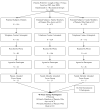In their own words: patients and families define high-quality palliative care in the intensive care unit
- PMID: 20198726
- PMCID: PMC3267550
- DOI: 10.1097/ccm.0b013e3181c5887c
In their own words: patients and families define high-quality palliative care in the intensive care unit
Abstract
Objective: Although the majority of hospital deaths occur in the intensive care unit and virtually all critically ill patients and their families have palliative needs, we know little about how patients and families, the most important "stakeholders," define high-quality intensive care unit palliative care. We conducted this study to obtain their views on important domains of this care.
Design: Qualitative study using focus groups facilitated by a single physician.
Setting: A 20-bed general intensive care unit in a 382-bed community hospital in Oklahoma; 24-bed medical-surgical intensive care unit in a 377-bed tertiary, university hospital in urban California; and eight-bed medical intensive care unit in a 311-bed Veterans' Affairs hospital in a northeastern city.
Patients: Randomly-selected patients with intensive care unit length of stay >=5 days in 2007 to 2008 who survived the intensive care unit, families of survivors, and families of patients who died in the intensive care unit.
Interventions: None.
Measurements and main results: Focus group facilitator used open-ended questions and scripted probes from a written guide. Three investigators independently coded meeting transcripts, achieving consensus on themes. From 48 subjects (15 patients, 33 family members) in nine focus groups across three sites, a shared definition of high-quality intensive care unit palliative care emerged: timely, clear, and compassionate communication by clinicians; clinical decision-making focused on patients' preferences, goals, and values; patient care maintaining comfort, dignity, and personhood; and family care with open access and proximity to patients, interdisciplinary support in the intensive care unit, and bereavement care for families of patients who died. Participants also endorsed specific processes to operationalize the care they considered important.
Conclusions: Efforts to improve intensive care unit palliative care quality should focus on domains and processes that are most valued by critically ill patients and their families, among whom we found broad agreement in a diverse sample. Measures of quality and effective interventions exist to improve care in domains that are important to intensive care unit patients and families.
Conflict of interest statement
The authors have not disclosed any potential conflicts of interest.
Figures
Comment in
-
Qualitative research: the chicken or the egg.Crit Care Med. 2010 Mar;38(3):987-8. doi: 10.1097/CCM.0b013e3181cc145c. Crit Care Med. 2010. PMID: 20168157 No abstract available.
References
-
- [Accessed June 30, 2009];National Priorities Partnership convened by the National Quality Forum. Available online at: http://www.qualityforum.org/about/NPP/
-
- Field MJ, Cassel CK, editors. Approaching death: Improving care at the end-of-life. Washington DC: National Academy Press; 1997. - PubMed
-
- Angus DC, Barnato AE, Linde-Zwirble WT, et al. Use of intensive care at the end of life in the United States: An epidemiologic study. Crit Care Med. 2004;32:638–643. - PubMed
-
- Carlet J, Thijs LG, Antonelli M, et al. Challenges in end-of-life care in the ICU/Statement of the 5th International Consensus Conference in Critical Care: Brussels, Belgium, April 2003. Intensive Care Med. 2004;30:770–784. - PubMed
-
- Nelson JE, Danis M. End-of-life care in the intensive care unit: Where are we now? Crit Care Med. 2001;29:N2–N9. - PubMed
Publication types
MeSH terms
Grants and funding
LinkOut - more resources
Full Text Sources
Other Literature Sources
Medical


